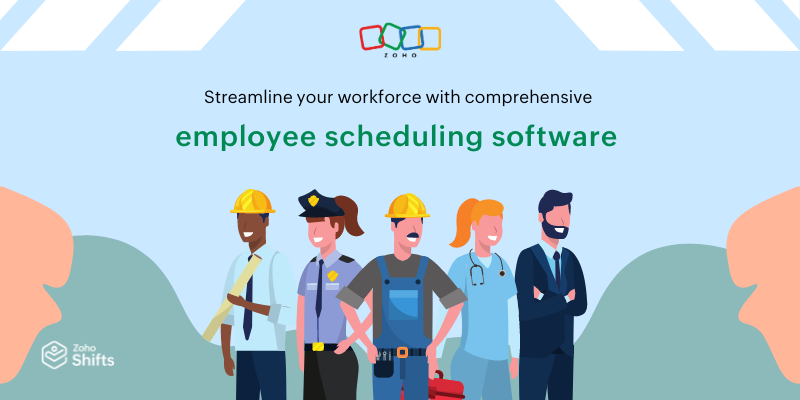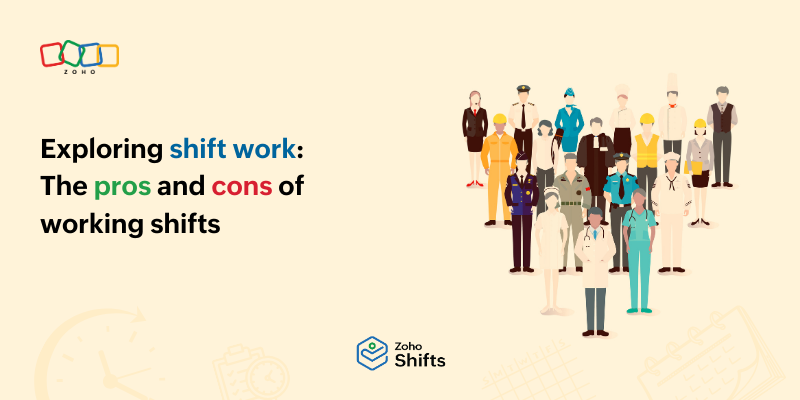- HOME
- Shift Scheduling
- Exploring rotating shifts and their types
Exploring rotating shifts and their types
- Last Updated : May 6, 2024
- 848 Views
- 7 Min Read
Companies operating 24/7 have become more common than ever before. Businesses need to extend beyond the traditional hours to provide the best service to their customers. Scheduling work for employees working around the clock can often be challenging, as it requires balancing the needs of the business while ensuring employee satisfaction.
To meet customers' needs or production demands, employers utilize various shift models to manage their business. Rotating shifts are one among the many methods used to manage shifts and are now common across many industries.
What are rotating shifts?
As the name suggests, rotating shifts are shifts that keep changing over time. Employees working rotating shifts will work varying schedules at different times of the day. They could be working the day shift one day and the night shift a few days later. They could also have shifts scheduled on weekdays or weekends, depending on the nature of the business.
The main reason for implementing rotating shifts is to ensure someone is always available to manage any business requirements. In addition, rather than just one person working the uncomfortable shift in an organization, the burden of these shifts can be distributed among all employees evenly.
Consider the case of a restaurant that is open 24/7. There needs to be a shift system in place that ensures customers are always attended to. A set of employees will work the traditional 8 am to 4 pm shift, the second set for the evening shift from 4 pm to midnight, and a third set of employees will work from midnight till the start of the first shift the next day. These employees may rotate their shifts on a daily, weekly, or monthly basis based on the preference of the employer. The main difference compared to traditional shifts is the variation in the shift schedules for each employee.
Why are rotating shifts needed?
Using rotating shifts can alleviate some of the common issues that come with scheduling in an organization. They give companies much-needed flexibility to keep up with varying business demands. The constant change in the schedules can also ensure that new employees get to work with the more experienced ones and gain valuable experience.
Since employees take turns covering the shifts, no employee will be stuck with the same shift permanently. This means all employees will get a good mix of both the supposed good and bad shifts in an organization. This helps keep employees satisfied and allows the business to cater to the different demands that come with each shift.
The benefits of using rotating shifts
No employee has to consistently work the same schedule
In organizations that work round the clock, it can be difficult to find employees to work certain schedules (especially the night shift) consistently. Using rotating shifts can ensure one person does not have to work the same inconvenient shift all the time.
Gain experience
The nature of the tasks and the requirements may vary from one shift to another. Rotating and working in each shift periodically can provide employees with more experience and help them be better prepared for any type of situation in the workplace.
Round-the-clock availability
One of the biggest advantages of rotating shifts is that it ensures employees are available 24/7. Consistent availability of employees helps ensure customer demands are always met regardless of the time of the day.
Daytime free hours
With work schedules not fixed to the traditional 9 am to 5 pm, employees have more options to attend to their personal obligations during non-work hours. For instance, if an employee needs to schedule a doctor's appointment, they can do so on days when they're working second or third shift as well as on their days off.
Industries where rotating shifts are used
Rotating shifts are best suited for industries that need to function outside of the traditional work hours or operate round the clock while ensuring that none of the employees are overworked or have the need to work overtime.
Healthcare
Healthcare professionals are needed 24/7 to provide patient care and manage emergency cases. Having rotating shifts can help ensure everyone in a hospital is well rested to provide the best possible care for the patients. This also ensures the best doctors are not only available during the same shift every day.
Transport and logistics
There are many roles in the transportation industry that may have to work around the clock, including truck drivers, rental car drivers, or other logistics staff. Businesses can use rotating shifts to ensure that staffing demands are always met.
Hospitality
Hotels, restaurants, event planners, caterers, and more make up the hospitality industry. The main goal of hospitality is to ensure maximum customer satisfaction and to provide an enjoyable experience overall. Rotating shifts can be used to ensure employees are available at all times without overworking them.
Manufacturing
Manufacturing industries generally involve continuous production, which isn't possible while working only traditional daytime hours. Employees working in this industry need to be available to ensure non-stop operations, but it's vital to ensure they are not so overworked that it poses safety risks. Rotating shifts are a great method to find the perfect balance between the two.
Types of rotating shifts
Here are some of the most common methods to implement rotating shifts:
2-2 3-2 2-3
This is probably the most basic way to implement rotating shifts. The name of this shift comes from the pattern of days that the employees work. In this type of rotating schedule, there are 4 teams and two 12-hour shifts to provide complete coverage at all times. After 2 weeks, the day and night shifts trade, and the cycle will repeat after 4 weeks.
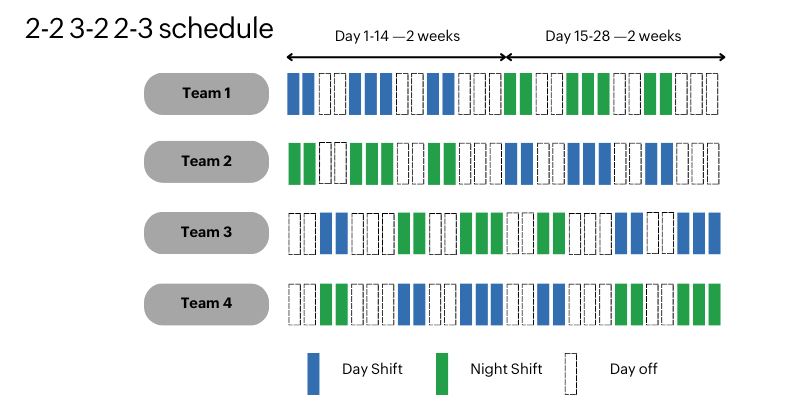
DuPont
The DuPont schedule also makes use of two rotating 12 hour shifts with 4 teams to ensure the 24 hours are covered. This shift cycle also runs for 4 weeks.
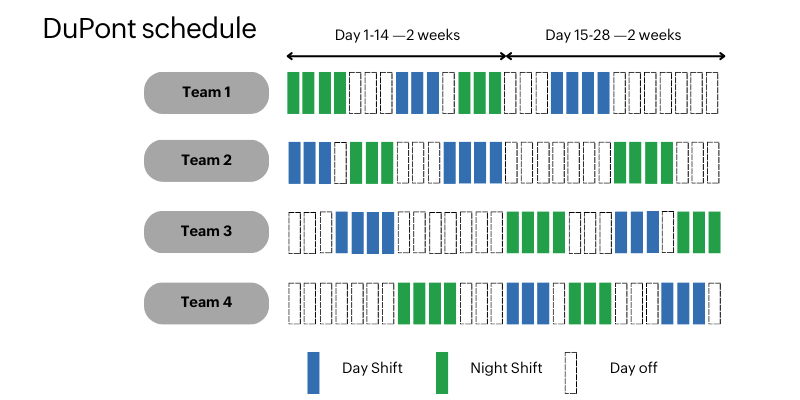
The continuous nature of the DuPont shifts may be stressful for some workers. Quickly switching between day and night shifts without many rest days in the middle can be stressful and affect employees' sleep pattern and health. Consecutive days off are provided to compensate for the nature of the work schedule. The schedule ends with an entire week off to recuperate and get ready for the next cycle.
While the long breaks give sufficient time for employees to spend time with family and friends, the trade-off is difficulty adjusting to the changing hours for the rest of the days. Employees' overall health and well-being can be affected if they work on the DuPont schedule for a long time, but the schedule might suit people who are willing to work for longer hours to enjoy more time off.
Pitman schedule
The Pitman schedule works similarly to the DuPont and 2-2 3-2 2-3 schedules, with 4 teams working rotating 12 hour shifts. The only difference here is two teams will only work day shifts, and two teams will only work night shifts.
Here is what a typical Pitman schedule looks like for the day shift for 4 weeks:
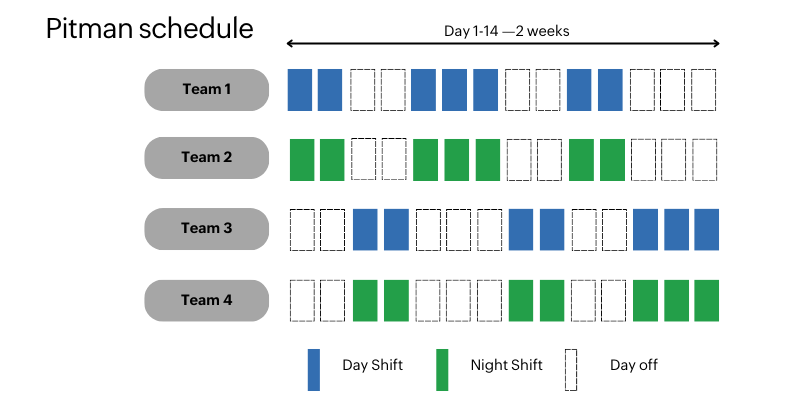
Two of the teams will follow the same schedule, and the other two will follow the same pattern but with night shifts. Another modification of this is the rotating Pitman schedule, where teams switch between day and night shifts on a biweekly basis.
24/48 schedule
This type of schedule uses three teams that work 24-hour shifts, followed up by a 48-hour break.
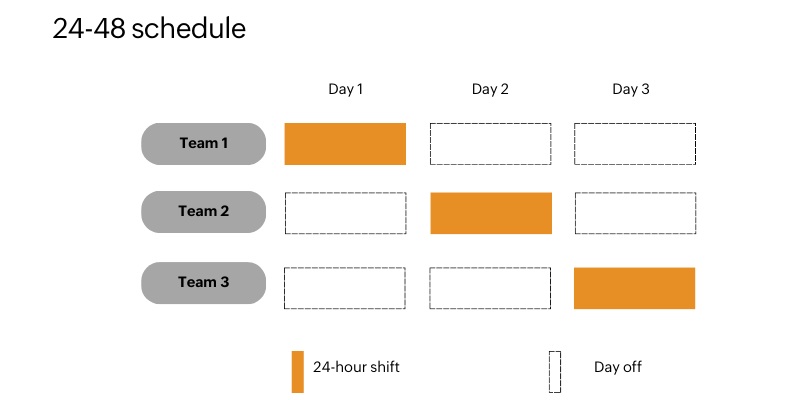
The number of continuous hours required in this type of schedule can be stressful and difficult for many employees to get acclimatized to. This type of shift is usually used in the healthcare sector and other emergency services.
The downside of rotating shifts
While rotating shifts can help to provide coverage for your business at all times, some challenges come with implementing this shift system. Here are some of the drawbacks of implementing rotating rosters in the workplace.
Employee well-being
Employee health is negatively affected when their shifts are constantly changing from one to another. The schedule irregularity directly impacts sleep patterns and disrupts the circadian rhythm, causing sleep deprivation, insomnia, and other potential health issues. The lack of time to recover between shifts can result in burnout and loss of motivation.
Decreased productivity
Working in rotating shifts can lead to increased fatigue among employees. This can in turn impact productivity levels and increase the number of errors in the workplace. In industries like manufacturing or transportation, this can lead to dangerous accidents.
Impacts on social life
Working rotating shifts can impact employees' social life and time spent with family. The lack of consistency in the work schedule makes it challenging to plan family events or social gatherings with friends.
Employee turnover
Working rotating shifts can be both physically and mentally challenging for workers, which can lead to increased attrition rates. Since many employees prefer to work shifts with normal and consistent hours, it can be difficult to attract and retain top talent in the workplace.
Rotating shifts gives businesses an efficient way to keep their businesses functioning 24/7 while facilitating a range of benefits such as cross-training and employee flexibility. However, there are also many drawbacks, such as disruption of sleep, social isolation, and reduced productivity. There are some measures that can be taken to reduce these factors if rotating shifts are necessary for your business. As an employer, you can provide notice in advance to your employees about which specific shifts they will be working. This can help them plan their personal lives around the shifts and make necessary arrangements. Ensuring shifts change from the first to the second shift and then to the third, rather than directly from first shift to third, can give employees the time to adjust to the different sleep patterns and help prevent impacts to their health.
Employee satisfaction is an important concern if you wish to use rotating shifts for your business. Be mindful that rotating shifts are not just a quick solution for the schedule, but also have an impact on the employees. Finding the perfect balance between the needs of your business and the well-being of your employees can help create the perfect rotating schedule.
